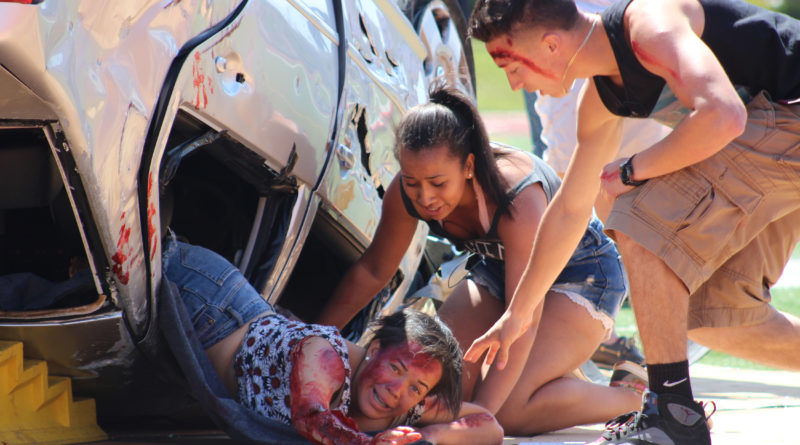Every 15 minutes program shakes CVHS students
There’s a knock on the door. Your loved ones open it to greet a police officer, who informs them that you have died as a result of a drunk driving collision.
Have you ever been in a situation where you were in the car driven by someone who was drunk, high, or distracted by their phone? Have you been that driver? The Every 15 Minutes Program combats the prevalence of this dangerous scenario.
This program is for juniors and seniors, mainly because many can legally drive. Its familiar name refers to a 1995 statistic that every 15 minutes, someone dies in an alcohol-related crash in the United States.
Starting at 8:15 a.m. on Thursday May 19, the names of “dead” students were called out over the loudspeaker every 15 minutes, two at a time. Officers came into their classrooms, and left a rose on each desk after reading their obituary. Once all of the names were called, all upperclassmen made their way to the field for the crash scene simulation.
Standing on the field and watching everyone file into the bleachers was when it really hit me that the next two days would be the most impactful days of the year.
Once everyone was seated, there was a horrific and loud screeching sound of a car accident, and senior Taylor Wade made a frantic 911 call, describing the terrifying scene of a collision involving senior Lexie Lange being ejected through the windshield, bloody and unresponsive on the hood of the car.
The other car was rolled over with student Cole Sanders trapped inside, and senior Margeaux Jackson screamed out in pain for help. Jackson then looked over to see her friend, Sarah Green, a pedestrian with an open femur fracture, who was drifting in and out of consciousness, unable to move.
The sober driver, Sam Higuera, was able to escape the wreckage and painfully yelled at Connor Piper, “What did you do?!” Piper was his friend who caused the accident due to impaired driving. Piper responded in a dazed and confused state, “It’s not my fault!”
First responders arrived on scene and students were taken away by ambulance, helicopter, and in Lange’s case, the coronary bureau.
As the audience left the assembly with emotions running high, student participants left for an overnight retreat, where we were unable to communicate with anyone to simulate what it would really feel like if we were dead.
We bonded and formed friendships throughout the course of the night and met a couple of speakers who told us their stories about drinking and driving, and how that had impacted their lives.
Perhaps the most difficult of the activities was writing a letter to someone who was important to you. I wrote my letter to my family. As we wrote our letters, our parents were at a separate retreat as well, writing letters to us as if we were dead.
After that, we sat in a large group and shared what had stood out to us throughout the day, and many of us commented on how all of us had become a family, and pledged to be more safe and never drink and drive.
We came back to school the next day at 7 a.m. and waited for the three heart-wrenching assemblies to begin. In the lobby of the Center for the Arts, student coordinator Kaitlyn Darling hung our school pictures and obituaries on the wall to be viewed before and after the assembly by family and friends.
Officer Wes Morgan introduced our speaker, Marcella Gomez, who survived a real car crash with her family that claimed the lives of her parents. Gomez suffered from brain damage and other physical disabilities as a result of the crash. The courage that Gomez had to tell us her story had a large impact on many students.
The highly anticipated video that followed illustrated what had happened leading up to the simulated accident. We filmed a party at Alameda Beach, depicting a group of friends having a good time while drinking and smoking before they tried to flee to their cars when the police showed up.
We were on the scene of the car crash the day before, but seeing the video all put together for the first time brought on new emotions. Parents of those that were killed or injured in the crash displayed true pain as they watched their child suffer or lose their life. I don’t think there was a single one of us from the program that didn’t cry, as well as many of the students who were attending the assemblies.
Some students went up to read the letters they had written the night before, as well as a few parents reading their letters to their children. The entire experience is something that made everyone more grateful for each day.
“Every 15 minutes, someone dies because of a drunk driver. Today, we lost you.” That’s something I never want my parents to have to say.
After almost 20 years since the program began, not only has the statistic been changed to every 51 minutes, but also, all of us have learned what an impact the loss of a life means to friends and family. Every 15 Minutes was a life-changing experience that I’m so grateful to have been a part of.
Some may have thought this was not very emotionally impactful, but the goal was to make students think twice before getting into a car with an impaired friend. I now think that it’s our job to take the initiative to do whatever we can to avoid what could be a terrible tragedy; take their keys and be a designated driver. They’ll be grateful the next day.


Great article, 10/10!